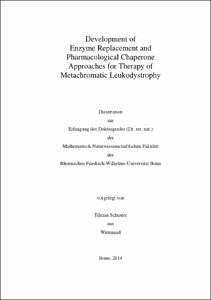Development of Enzyme Replacement and Pharmacological Chaperone Approaches for Therapy of Metachromatic Leukodystrophy

Development of Enzyme Replacement and Pharmacological Chaperone Approaches for Therapy of Metachromatic Leukodystrophy

| dc.contributor.advisor | Gieselmann, Volkmar | |
| dc.contributor.author | Schuster, Tilman | |
| dc.date.accessioned | 2020-04-20T04:22:16Z | |
| dc.date.available | 2020-04-20T04:22:16Z | |
| dc.date.issued | 06.01.2015 | |
| dc.identifier.uri | https://hdl.handle.net/20.500.11811/6213 | |
| dc.description.abstract | Metachromatic leukodystrophy (MLD) is a monogenic, autosomally recessively inherited lysosomal storage disease. Certain mutations of the arylsulfatase A (ASA) gene cause misfolding or absence of ASA. Physiologically ASA is responsible for the lysosomal degradation of 3-O-sulfogalactosylceramide (sulfatide), a main lipid component of myelin. Lack of ASA activity results in accumulation of sulfatide and consequently in demyelination processes, causing severe central nervous system pathology leading to premature death. Two therapeutic approaches for MLD were pursued in this thesis: enzyme replacement therapy (ERT) and chaperone therapy. For ERT recombinantly produced enzyme is injected intravenously. However, the blood brain barrier (BBB) prevents efficient transport into the brain, the main target of the disease. Therefore options to increase brain delivery were investigated. To this end ASA was bound to four different nanoparticle preparations that have been described to increase brain delivery of therapeutics. Inclusion during polymerization was unfeasible due to loss of ASA activity. Adsorption of ASA to the nanoparticle surface was efficient, however rapid and complete desorption was observed in presence of serum in vitro. In contrast, stable binding by direct crosslinking or high-affinity methods significantly reduced desorption in presence of serum. Two nanoparticle systems were thereon investigated with respect to their potential to increase brain delivery of ASA in vivo. However, contrary to the working hypothesis, brain delivery was not enhanced upon binding to nanoparticles in comparison to free ASA, although the overall biodistribution of ASA was altered. This was explained by rapid uptake via mannose 6-phosphate (M6P) receptor endocytosis. To reduce uptake by peripheral cells, a M6P binding domain was coupled to nanoparticles in order to physically shield ASA’s M6P residues that are recognized by M6P receptors on these cells. Indeed, in first in vitro experiments, shielding of ASA resulted in a reduction of uptake by M6P receptor expressing cells. In vivo, this effect would be expected to lead to prolonged blood circulation times and an increase in brain delivery. Chaperone therapy aims at restoring activity of misfolded enzyme molecules by stabilizing correct folding intermediates. Typically, pharmacological chaperones are small-molecule enzyme inhibitors and ideally cross the BBB. By means of high throughput screenings one ASA inhibitor was identified and subsequently characterized biochemically. This compound is to be further tested with respect to its use as a pharmacological chaperone. | en |
| dc.language.iso | eng | |
| dc.rights | In Copyright | |
| dc.rights.uri | http://rightsstatements.org/vocab/InC/1.0/ | |
| dc.subject | Lysosomale Speichererkrankungen | |
| dc.subject | Nanopartikel | |
| dc.subject | Blut-Hirn-Schranke | |
| dc.subject | Mannose-6-Phosphat-Rezeptor | |
| dc.subject | Arylsulfatase A | |
| dc.subject | High-Throughput-Screening | |
| dc.subject | Gewebeverteilung | |
| dc.subject | Lysosomal Storage Diseases | |
| dc.subject | Nanoparticles | |
| dc.subject | Blood-Brain Barrier | |
| dc.subject | Mannose 6-phosphate receptor | |
| dc.subject | Tissue distribution | |
| dc.subject.ddc | 570 Biowissenschaften, Biologie | |
| dc.subject.ddc | 615 Pharmakologie, Therapeutik | |
| dc.title | Development of Enzyme Replacement and Pharmacological Chaperone Approaches for Therapy of Metachromatic Leukodystrophy | |
| dc.type | Dissertation oder Habilitation | |
| dc.publisher.name | Universitäts- und Landesbibliothek Bonn | |
| dc.publisher.location | Bonn | |
| dc.rights.accessRights | openAccess | |
| dc.identifier.urn | https://nbn-resolving.org/urn:nbn:de:hbz:5n-38514 | |
| ulbbn.pubtype | Erstveröffentlichung | |
| ulbbnediss.affiliation.name | Rheinische Friedrich-Wilhelms-Universität Bonn | |
| ulbbnediss.affiliation.location | Bonn | |
| ulbbnediss.thesis.level | Dissertation | |
| ulbbnediss.dissID | 3851 | |
| ulbbnediss.date.accepted | 28.11.2014 | |
| ulbbnediss.institute | Medizinische Fakultät / Institute : Institut für Biochemie und Molekularbiologie (IBMB) | |
| ulbbnediss.fakultaet | Mathematisch-Naturwissenschaftliche Fakultät | |
| dc.contributor.coReferee | Burgdorf, Sven |
Dateien zu dieser Ressource
Das Dokument erscheint in:
-
E-Dissertationen (4367)




